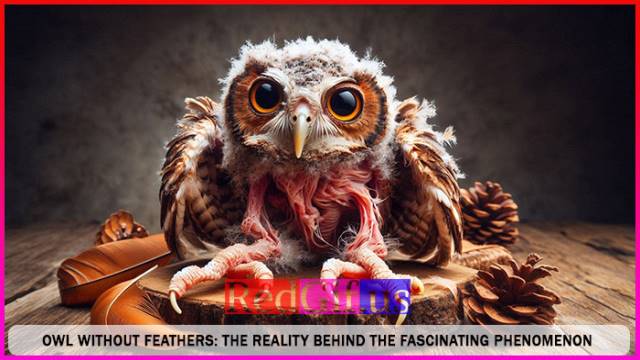Owl Without Feathers: The Reality Behind the Fascinating Phenomenon

Introduction
Owls have been fascinating us for ages with their mystique and big eyes. They’re birds of prey that symbolize wisdom and secrecy, often depicted as the guardians of the night. But have you ever wondered what an owl would look like without its feathers? If you’ve ever seen a picture of a featherless owl you might find it both cool and creepy. This post explores the reality of Owl Without Feathers, why they lose their feathers, what they look like and what it means for their survival.
Problem: Feathers are crucial for owls to fly, regulate their body temperature and blend in with their surroundings. A featherless owl faces many challenges that threaten its very existence. Understanding why owls lose their feathers can help with wildlife management and conservation.
Agitation: Imagine an owl – majestic and fierce – reduced to a vulnerable state without its feathers. It’s an unusual and unsettling sight. Without feathers they lose their natural defense mechanisms and are exposed to the elements making survival a tough ask. This isn’t just a cosmetic issue, it’s a life or death situation.
Solution: In this post we’ll look at the reasons why owls lose their feathers, the implications and existing case studies on this rare condition. By the end you’ll have a better understanding of how important feathers are to owls and why intervention is needed when they lose their feathers.
Why Feathers are Important for Owls
Before we get into why an owl might lose its Owl Without Feathers we need to understand why feathers are so important. Feathers do:
- Flight: Feathers provide the aerodynamics for owls to fly. Their wings are designed to be silent so they can sneak up on their prey. Without feathers an owl’s ability to hunt is severely compromised.
- Temperature Regulation: Feathers are insulation, owls keep warm in cold weather. Without them an owl would struggle to regulate its body temperature and would get hypothermia.
- Camouflage: Owls use their feathers to blend in with their surroundings, to avoid predators and sneak up on prey. A featherless owl would stand out, it would be an easy target.
Reasons for Feather Loss in Owls
Feather loss in owls can be due to several reasons. Some are natural, some are due to disease or environmental stress.
1. Molt:
Owls, like many birds, go through a natural process called molt where old feathers are shed to make way for new growth. During this time an owl may appear to have fewer feathers but this is a temporary phase. Molt happens in stages so the owl is never completely featherless at any time.
2. Disease and Parasites:
Feather loss can also be due to disease or parasites. Feather mites can cause significant feather damage while avian pox can cause lesions that lead to feather loss. In these cases the owl may lose feathers in patches and if not treated can be life threatening.
3. Nutritional Deficiencies:
A poor diet can cause feather loss. Owls need a diet rich in nutrients to have healthy feathers. In the wild a lack of prey can cause malnutrition which can lead to weak feathers that fall out easily.
4. Environmental Stressors:
Stressful environments such as habitat destruction or extreme weather can cause an owl to lose feathers. Stress weakens the bird’s immune system making it more prone to disease and parasites that cause feather loss.
Case Study: The Owl Without Feathers
One of the most famous featherless owl is from Brazil where a Barn Owl was found in a debilitated state completely featherless. The owl which was rescued and brought to a wildlife rehabilitation center looked very vulnerable.
Diagnosis and Treatment:
Upon examination the vet diagnosed the owl with severe avian pox which had caused the bird to lose all its feathers. The bird’s condition was further compounded by malnutrition probably due to inability to hunt without feathers.
The rehabilitation center provided the owl with a controlled environment where it was fed a nutrient rich diet and treated for avian pox. After several months the owl’s condition improved and it started to regrow its feathers.
Result:
The owl recovered but this case shows how important early intervention and nutrition is in wildlife rehabilitation. If not for the care it received it would not have made it.
Feather Loss
Feather loss in owls is not just a beauty issue; it’s a matter of life and death. A featherless owl is at a huge disadvantage in the wild:
- More Vulnerable: Without feathers for camouflage, owls are sitting ducks for predators.
- Mobility Issues: Flight is impossible without feathers so the owl can’t hunt or escape from danger.
- Thermoregulation Problems: Feathers are key to body temperature. Without them the owl will get hypothermia especially in cold climates.
- Reproductive Issues: A featherless owl may not be as attractive to potential mates so reproduction and population decline.
Conclusion
Owl Without Feathers is a rare but serious issue that shows how important feathers are to these magnificent birds. While natural molting is a normal and harmless process, feather loss due to disease, parasites or environmental stress can be life threatening. As the Brazilian Barn Owl case study shows, intervention and proper care can sometimes reverse the damage but prevention through conservation is key.
By spreading awareness about the importance of feathers and the threats that can cause feather loss, we can better protect these amazing birds. If you ever see an owl or any bird with missing feathers, contact wildlife professionals who can help.
FAQs
Q1: Can an owl live without feathers?
A1: An owl can live temporarily without some feathers but a completely featherless owl has big problems, can’t fly, can’t regulate body temperature and can’t avoid predators. Survival in the wild would be almost impossible without intervention.
Q2: Why does an owl lose its feathers?
A2: Feather loss in owls can be due to molting, avian pox, feather mites, nutritional deficiencies or environmental stressors. Each cause requires different treatment and intervention.
Q3: What can you do for a featherless owl?
A3: If you see a featherless owl, contact a wildlife rehabilitation center. They can give medical care and a safe place for the owl to recover and regrow its feathers.


